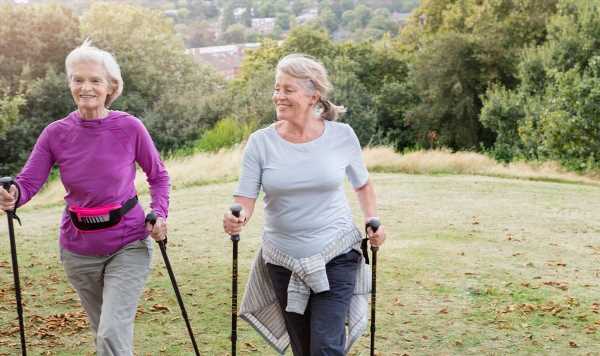This Morning: Rochelle Humes reveals awkward exercise blunder
We use your sign-up to provide content in ways you’ve consented to and to improve our understanding of you. This may include adverts from us and 3rd parties based on our understanding. You can unsubscribe at any time. More info
The study, published as a part of the Physical Activity Guidelines for Americans, suggested that exercise for those over the age of 65 could be particularly beneficial in helping reduce their risk of death.
The authors specified that balance training, muscle-strengthening activities, and “moderate to vigorous aerobic physical activity” all played a role in life longevity.
Their conclusions were reached after analysis of data from a 20-year survey, known as the National Health Interview Survey, and comparison to the National Death Index mortality files.
Participants in the study were predominantly women who made up just over 57 percent of the 115,489 participants in the study.

The authors concluded in their discussion: “Leisure time MSA and MVPA were independently associated with lower all-cause mortality in this cohort study of US adults aged 65 years or older.
“By using finer age and physical activity categories, a larger sample, and longer follow-up, we build on earlier studies, and offer new insights for older adults and their health care professionals.”
Meanwhile, the CDC (Centre for Disease Control and Prevention), who were involved in the study, spoke to CNN on the results. They said: “We found that each type of physical activity was independently associated with a lower risk of all-cause mortality in older adults,” Webber said in an email.
“Those who met the muscle-strengthening guideline only (versus neither guideline) had a 10 percent lower risk of mortality; those who met the aerobic guideline only had 24 percent lower risk of mortality, and those who met both guidelines had 30 percent lower risk.”
They added that their findings suggested “that aerobic and muscle-strengthening physical activity is valuable throughout the lifespan”.
Furthermore, they also had some recommendations for using exercise to improve ageing.
They recommended at least 150 minutes a week of moderate intensity activity, two days a week, of activities that strengthen muscles, and engaging in activities which help improve balance three times a week.
However, they cautioned: “If chronic conditions affect your ability to meet these recommendations, be as physically active as your abilities and conditions allow.”

Overall, their message was to move more and sit less, particularly for older people.
They wrote: “Older adults should move more and sit less throughout the day. Keep in mind, some physical activity is better than none.
“Older adults who sit less and do any amount of moderate-to-vigorous intensity physical activity gain some health benefits. Your health benefits will also increase with the more physical activity that you do.”
The CDC’s update is part of a growing body of evidence showing that exercise can help with ageing.
This has been reflected by studies in the past which have shown similar results, including a paper published by the University of Birmingham in 2018.

The study, conducted in tandem with King’s College London, showed that those who regularly exercised were more likely to age less.
The University of Birmingham’s Dr Janet Lord said of the results: “Hippocrates in 400BC said that exercise is man’s best medicine, but his message has been lost over time and we are an increasingly sedentary society.
“However, importantly, our findings debunk the assumption that ageing automatically makes us more frail.
“Our research means we now have strong evidence that encouraging people to commit to regular exercise throughout their lives is a viable solution to the problem that we are living longer but not healthier.”
Source: Read Full Article
